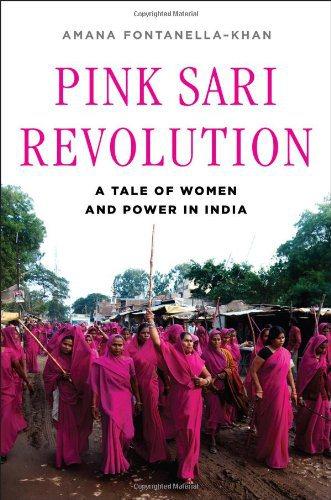Amana Fontanella-Khan’s Pink Sari Revolution tells the story of Sampat Devi Pal and her infamous Gulabi Gang, a women’s group based out of Uttar Pradesh(UP) in India, while following the controversial case of Sheelu Nishad vs Purushottam Naresh Dwivedi from 2009. Involuntarily, the book is a demonstration in the intersectionality between the problems rural Indian society faces: incredible poverty, the wretched caste system, the institution of untouchability that is upheld staunchly in rural UP, child marriage, the discriminatory lack of education for women, rape culture, corruption: dirty government officials, dirty policemen, and dirty politicians.
Many of the stories are reconstructed from the author’s interviews with Sampat Pal and her acquaintances; her beginnings, perseverance, success, temptations. Back stories of all the characters weave through the book, forming the pieces of the puzzle that is the Sheelu case, and the intertwined members of the Gulabi Gang. Sampat Pal is resourceful, bold and inspiring; call her a moral brigand, vigilante for women’s issues, or the just the heroine of this captivating book. Her character unfolds slowly and clearly, and as we move through the narrative she has many tones and textures: courage, irreverence, pink sari, heedlessness, rural Hindi, et al.
Often, it is challenging to discuss Indian feminist movements objectively in a global perspective. Like most things Indian, women’s rights requirements in India are diverse and stratified, and even basic concepts need to be redefined to the Indian context. In giving things cold, straight frames of reference, the author succeeds immensely. If you are unfamiliar with the problems faced by women in different socio-economic strata in the country, the author gives you axiomatic context, with simple, true statements. If you grew up in India or are familiar with the variety of situations that arise at the grassroots level, these sentences are like crisp bursts of cold water; non-judgemental and matter of fact.
When I began reading the book, I was intrigued by the it’s objectivity: the descriptions came together to form images of muddy, cold roads in rural Uttar Pradesh, women in pink saris who functioned with a courage that relied on moral correctness and strength in numbers. Everything was earthern, ugly, un ‘dented or painted’, yet nothing was judged or treated with condescension based on unfamiliarity. A factor that alienates several descriptions of the grassroots in India, be it in print or film, is an overall lack of empathy to the people and their gray areas, and in that problem, Fontanella-Khan beats with ease.
The book ends, if somewhat abruptly, calling attention to the huge problem of rape in India, and it’s major contributing factors: the attitude of the society towards women, and the the corruption in law and order in rural and many urban areas. With appalling, archaic laws that allow sex offenders to use the ‘character’ of the complainant as a defense, medical tests for rape being administered and judged differently to virgins and non-virgin victims, India has a long way to go in varying aspects of fixing it’s situation with women’s rights, safety and well being. The Gulabi Gang, although relatively nascent and not incorruptible, provides optimism for what we know, is a long and winding journey.

Pink Sari Revolution: image from Amazon.com
